 Review Article
Review Article
A Comprehensive Evaluation of Sustainable Self- Healing Cementitious Materials-Review
Mohamed Alazhari*
Department of Civil Engineering, University of Tripoli, Libya
Mohamed Alazhari, Department of Civil Engineering, University of Tripoli, Tripoli 13110, Libya
Received Date:November 23, 2023; Published Date:December 19, 2023
Abstract
In times the concept of self-healing concrete has gained attention from scholars and become a new area of study, in the construction field. The main focus of this effort has been to explore approaches using chemicals, bacteria and additives to prevent or repair cracks in concrete structures. This review aims to clarify the definitions of self-healing terminology established by scientific societies; The Japan Concrete Institute (JCI) Committee, RILEM and Van Tittelboom, K. & De Belie’s definition. Additionally, we provide an assessment of different techniques related to self-healing and remediation in concrete. Our review chapter examines the range of self-healing agents used to tackle micro-cracks in compositions along with an analysis of the testing methods employed to evaluate their effectiveness in the healing process.
Keywords:Concrete; Bacteria; Cracks; Self-healing; Healing-agents
Introduction
Concrete stands as the preeminent construction material, renowned for its facile castability and cost-effectiveness. However, a prominent drawback inherent to concrete resides in its limited tensile or flexural strength, inevitably resulting in the formation of cracks at any stage of a concrete structure’s lifecycle. These fissures can emanate from diverse sources, encompassing intrinsic material properties (as exemplified by material property inhomogeneity), prolonged loading, design oversights, or the deleterious influence of aggressive environmental factors. The consequences of these cracks extend to compromise the durability of concrete structures.
Recent research endeavors have yielded concrete formulations imbued with the intriguing capability to spontaneously restore a portion of their performance within a compressed timeframe. This phenomenon, stemming from the study of self-healing, holds empirical promise. Rigorous investigations have unequivocally demonstrated concrete’s intrinsic ability to autonomously seal cracks, commonly recognized as autogenous healing, wherein the material undertakes self-reparation without the addition of external healing agents. Prominent scholars [1-4] have diligently explored variables encompassing crack width, water pH, water hardness, and hydrostatic pressure’s role in autogenous healing. Significantly, autogenous healing materializes through varied modalities, including physical, chemical, and mechanical mechanisms [5].
A Comparison of Existing and Proposed Definitions, for the Self-Healing Phenomenon
The phenomenon of self-healing has been a subject of investigation and definition by multiple authors [6-8], Notably, these definitions reveal notable disparities in interpretation, particularly concerning terms such as “autogenous,” “autogenic,” and “autonomic” self-healing. The synthesis of these varied definitions is succinctly presented below.
The Japan concrete institute (JCI) committee
The JCI Committee conducted a comprehensive study of selfhealing and formulated precise definitions for each technical aspect associated with this phenomenon [8] as shown in Figure 1.
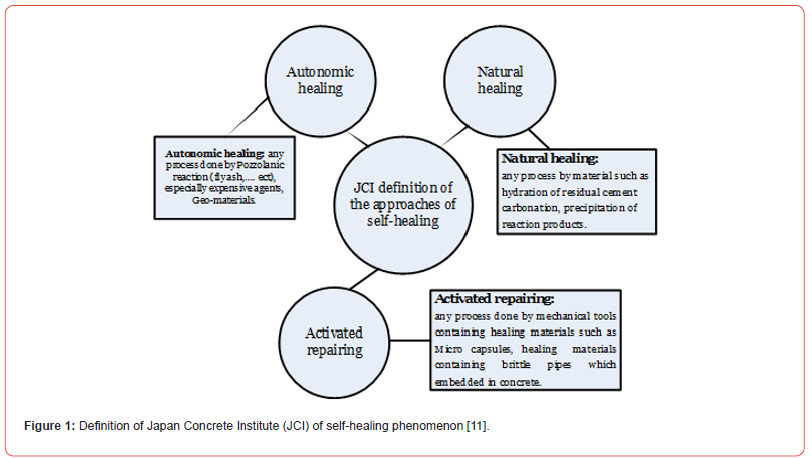
RILEM defined [9]:
The self–healing, as “any process by the material itself involving
the recovery and subsequent improvement of performance
following an earlier action that had compromised the material’s
performance”. RILEM further categorizes the self-healing process
into:
Autogenic: “the self-healing is autogenic when the recovery
process uses materials component that could otherwise also be
present when not specifically designed for self-healing”.
Autonomic: “the self-healing process is autonomic when the
recovery process uses material components that would otherwise
not to found in the material”.
Definition of self-healing given by Van Tittel boom, K. & De Belie [10]
Van Tittel boom and De Belie’s delineation aligns autogenous healing with the concept of natural healing as put forth by JCI. However, they classify autonomic healing as a subset of autogenous healing, denoting it as modified autogenous healing or improved autogenous healing, contingent on the introduction of supplementary materials to enhance healing efficiency. It’s noteworthy that a disparity emerges between RILEM and JCI definitions regarding autonomic healing, with RILEM’s description equivalently encompassing both autonomic and activated repairing self-healing, as delineated by JCI. Figure 1
The proposed definition in this research for the healing phenomenon stratifies it into three distinctive categories: autogenous, autogenomic, and autonomic. This proposed definition closely aligns with the conceptual framework presented by the Japan Concrete Institute (JCI). Furthermore, we introduce an innovative term, “autogenomic,” encapsulating the amalgamation of autogenous and autonomic healing mechanisms. This concept is visually articulated in Figure 2. The neologism “autogenomic” derives from the synthesis of “autogenic” and “autonomic” (autog+nomic), symbolizing the confluence of these two modes of healing.
Let A symbolize autogenous healing, B represent autogenomic healing, and C denotes autonomic healing. The interrelationships among these three categories can be succinctly conveyed through a Venn diagram:
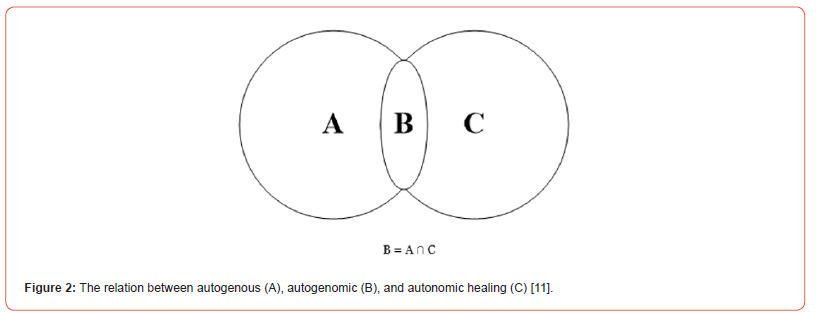
Definition and types of Self-Healing Phenomena
Researchers have been studying the concept of self-healing phenomenon for many years [12-17]. However, it is important to address a common misunderstanding regarding the impact of selfhealing on permeability. Specifically, the belief that self-healing leads to reduced permeability needs to be reconsidered. This misconception becomes evident in the conclusions reached by investigators, where the measurement of inflow holds considerable significance. Nonetheless, due to the absence of specialized assessments focusing on permeability in this specific context, we still lack a clear understanding of how fluid flows within self-healed concrete due to its complex dynamics [18,19].
Understanding the intricate mechanisms and contextual factors at play in healing is crucial. Such knowledge plays a pivotal role in designing resilient healing systems for high-performance concrete structures. In this comprehensive examination, we meticulously analyze three distinct categories of self-healing: autogenic selfhealing, autogenomic self-healing, and autonomic self-healing (Figure 3 visually presents these categories). These classifications provide an essential framework that enhances our comprehension and strategic utilization of self-repairing mechanisms, thereby driving advancements in materials science for concrete applications. Self-healing phenomena can be categorized into different types based on their underlying mechanisms and principles. These categories are explored as follows:
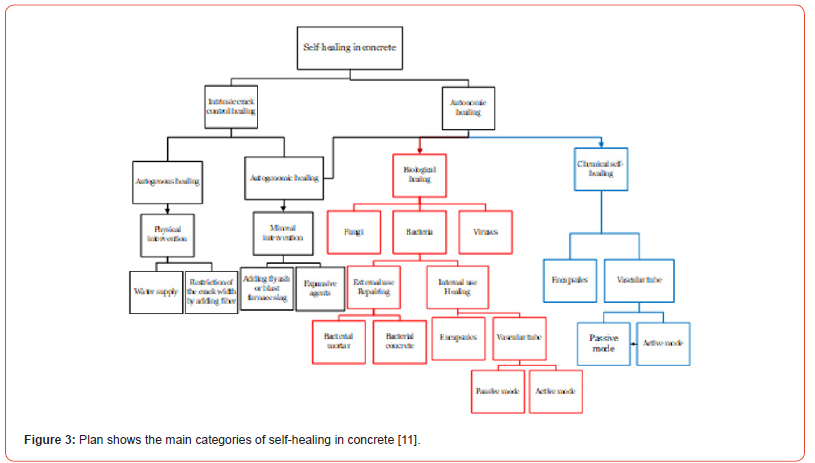
Autogenous Self-Healing
Autogenous self-healing denotes the inherent ability of cementitious materials to counteract environmental degradation, even in the presence of infiltrating water. To comprehend this selfdefensive attribute, the concept of “natural self-healing,” expounded by Hearn [18], comes to the forefront. The first tool, manifested through a physical mechanism, triggers the swelling of hydrated cement paste adjacent to crack boundaries, resulting in crack closure. The degree of swelling exhibits a proportional relationship with the tightness of crack closure.
The second tool involves chemical processes, characterized by
two distinct forms:
a. As water permeates cracks, the pre-existing anhydrite
cement undergoes hydration, generating novel compounds that
expand into crack voids. It is imperative to acknowledge that
sustained hydration alone does not suffice for comprehensive
self-healing. However, a limited crack width scenario
encompassing cement paste + sand (0.05mm-0.1mm) on the
micro/mesoscale [20], in conjunction with concurrent physical
swelling, yields successful self-healing for crack widths
surpassing 0.1mm. Subsequently, the significance of cement
hydration and swelling wanes as crack width escalates.
b. The second form involves the growth of crystals and
calcium carbonate deposition along the entire crack length,
prompted by a chemical interaction between carbonate and
calcium ions present in concrete’s pore water. This culminates
in the precipitation of calcium carbonate, effectively sealing
the crack. The efficacy of this process hinges upon factors like
temperature and pH, as elucidated through prior investigations
[21].
c. The third tool is mechanical self-healing encompasses
two aspects:
d. A minor contribution to autogenous self-healing is
observed when unbound fine particles traverse cracks
facilitated by water. Over time, these particles aggregate within
the crack, inducing partial healing.
e. The second facet arises from crack formation, resulting
in the fragmentation of minute concrete particles. These
fragments embed themselves in the crack surfaces, partially
obstructing its trajectory.
Autogenomic Self-healing
Autogenomic self-healing constitutes an extension of autogenous healing, where crack width control is achieved through the introduction of external materials. The efficacy of autogenous self-healing within the confines of limited crack widths, approximately 300 μm [22], underscores the need for engineering strategies. One approach involves the integration of fibrereinforced strain hardening to regulate crack width. Alternatively, the autonomous incorporation of agents promotes an autogenous healing state. Van Tittelboom, K. & De Belie [10] propose a robust methodology termed “modified autogenous self-healing,” wherein superabsorbent polymers (SAP) are infused into cementitious material, ensuring an augmented water supply. Upon crack initiation, moisture ingress prompts SAP expansion and migration to the crack, affecting physical closure. Additional strategies for autogenomic healing encompass partial cement substitution with materials such as fly ash or blast furnace slag, recognized catalysts for crystal deposition during autogenous self-healing.
Autonomic self-healing
Autonomic self-healing pertains to material resilience against environmental degradation without external intercession. This mechanical healing process for repairing damaged structures can be summarized in the following.
Capsule-based autonomic healing materials
Microencapsulation, an established technique since the
1950s, has pervaded diverse industries including construction,
food, pharmaceuticals, textiles, and chemicals [23]. Pertinently,
researchers endeavor to instil autonomic self-healing within
concrete via bacterial spore encapsulation [24-28] and chemical
encapsulation [27,29,30]. The efficacy of microcapsules hinges on
their capacity to withstand forces during concrete deformation [30,
31] and resist polymerization during mixture formulation [31-33].
Three principal microcapsule fabrication methods emerge [23].
a. Polymerization method,
b. Coacervation method,
c. Mechanical method. Parameters such as microcapsule
diameter and thickness mandate meticulous consideration during
the design process.
The integration of self-healing microcapsules offers a promising remedy to counteract the predicaments linked with internal cracking and micro-cracking within concrete structures. This progressive methodology encompasses a deliberate dispensation of a self-healing agent sourced from microcapsules that have been meticulously incorporated into the concrete matrix. The rupture of these microcapsules, prompted by the advancement of internal cracks within the concrete framework, orchestrates a controlled discharge of the self-healing agent into the afflicted area. The orchestration of this discharge is a result of the combined influence of gravitational and capillary forces.
Upon contact with the damaged region, the self-healing agent undergoes a reaction triggered by various factors, such as moisture, air exposure, elevated temperatures, or chemical interaction with the cementitious matrix. Additionally, the released self-healing agent can also react with chemically added admixtures within the concrete mix. The process of microcapsule self-healing involves the polymerization of the healing agent, which offers several distinct advantages [24]. These benefits encompass a low rate of shrinkage during the polymerization process, an extended lifespan of the healing effects, and a desirable low viscosity of the healing agent. Microcapsules used in this self-healing approach can take on various shapes, such as spherical or cylindrical forms. A visual representation of the usage frequency of each shape within the research community during the period from 2013 to 2022 is depicted in Table 1.
Table 1:Percentage of main parameters of microcapsules in self-healing concrete.
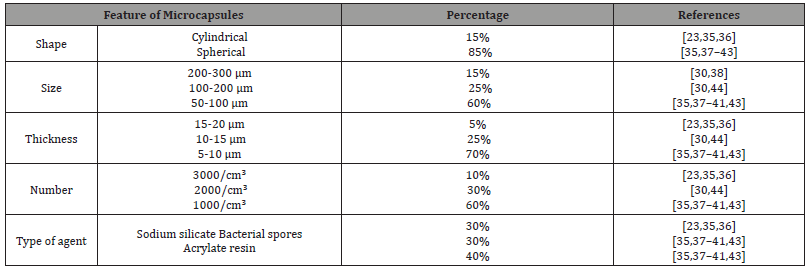
Vascular autonomic self-healing
The vascular autonomic self-healing materials approach involves the incorporation of repair material within hollow fibers or tubes that establish a connection between the structure’s interior and exterior, thus integrating the repair matrix prior to any potential damage occurrence. This system can adopt a singular channel vascular system, enabling the transportation of a single healing agent component, or a multi-channel system that employs a combination of diverse healing agents. As a consequence, in the event of cracking, the encapsulated healing material is released from within the tubes or fibers, seamlessly permeating the structural matrix.
Subsequently, these liberated healing materials infiltrate the cracks and effectively re-establish bonds with the original structural material. The concept of self-healing and repair has garnered attention from various researchers since its inception in 1990 by Dry, who initially introduced this approach for passive smart self-repair across a spectrum of structures, including beams, frames, and bridges [45-49]. Further exploration of this approach has been undertaken by other scholars [37,38], wherein different healing agents were employed. Figure 4 offers a visual comparison between the utilization of vascular self-repair and encapsulated healing methods during the same timeframe (2010-2022).
Bioengineered concrete
Synthetic materials, such as epoxies, have been employed for concrete crack remediation. However, the use of these materials is marred by several drawbacks. Notably, they exhibit disparate thermal expansion coefficients in comparison to concrete, leading to potential compatibility issues. Additionally, these materials pose concerns for both the environment and health hazards due to their composition. In light of these limitations, an environmentally friendly alternative emerges in the form of bacterial concreteinduced calcium carbonate precipitation. This technique capitalizes on the natural action of bacteria to promote the formation of calcium carbonate, effectively aiding in crack repair. Furthermore, the concept of self-healing concrete holds substantial promise in addressing the persistent issue of cracked concrete. By integrating intrinsic repair mechanisms, self-healing concrete presents an avenue to mitigate the substantial costs associated with repairs. A pivotal factor governing the evaluation of self-healing efficacy is the dominant criterion of cost reduction.
Classification of bacteria
Bioengineered concrete realm, bacteria play an essential role in leading processes that consolidate the material’s properties and functionality. Bacteria classification provides perspicacity into their functionality, suitability, and taxonomy for numeric applications within the construction industry field.
Classification based on function
Bioengineered concrete can be categorized based on the
functional roles of bacteria that contribute to enhancing concrete
properties. This classification sheds light on the diverse capabilities
of bacteria within the concrete matrix, driving favorable alterations.
a. The ability of bacteria to precipitate calcite: the capability
of bacteria to induce the precipitation of calcium carbonate CaCO3.
There are mainly three groups of microorganisms in nature that
produce calcite [52] namely,
i. Sulfate-reducing bacteria,
ii. Photosynthetic microorganisms, and
iii. some types of microorganisms participate in the nitrogen
cycle.
b. PH-Adjusting bacteria: Certain bacteria modify the pH
environment within the concrete matrix [53, 54], aiding in the
prevention of corrosion of reinforcing materials and enhancing
the overall longevity of the structure.
c. Nutrient-Producing Bacteria: Some bacteria generate
nutrients that promote the growth of other beneficial
microorganisms, supporting a holistic ecosystem within the
concrete environment.
Classification based on Taxonomic
The classification of bacteria in this aspect is based on genus and species. Bacteria are classified based on their distinct genetic and physiological attributes, leading to the identification of specific genus and species. This classification aids in the selection of bacteria suitable for particular concrete enhancement processes.
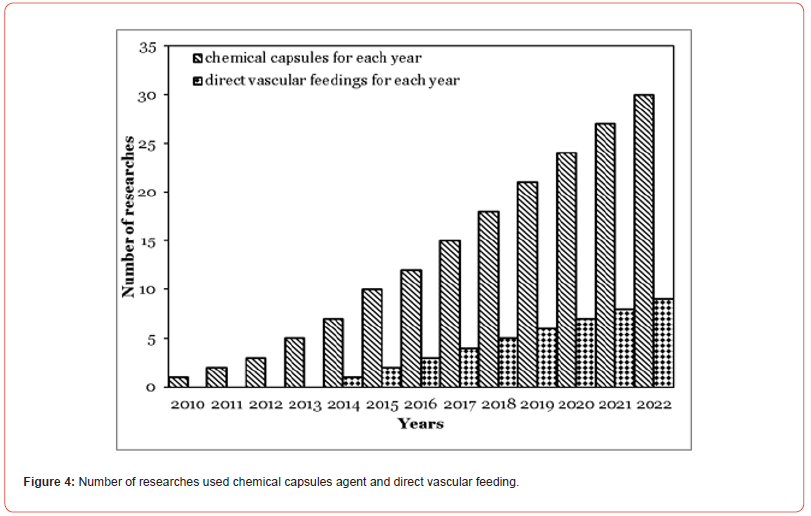
Classification based on Selection Criteria
The selection of bacteria for bioengineered concrete depends
on various factors including:
a. Compatibility: Bacteria chosen for a particular application
must be compatible with the concrete mix and exhibit minimal
adverse interactions.
b. Longevity: Bacteria that exhibit sustained viability and
functionality over time are preferred to ensure the long-term
effectiveness of bioengineered concrete.
c. Environmental conditions: The ability of bacteria to thrive
and perform optimally in the concrete environment, including
considerations of temperature, moisture, and nutrient
availability.
d. Specific functionality: Bacteria are selected based on
their ability to perform in-demand functions, such as CaCO3
precipitation or pH adjustment.
Viability of bacteria in concrete
Bacterial surfaces assume a pivotal role in the process of calcium precipitation [55]. This significance is attributed to the presence of negatively charged functional groups, particularly evident under specific pH conditions, which facilitate the accumulation of positively charged metal ions on bacterial surfaces. Conventionally, the external surfaces of bacterial cells become sites for the gradual formation of carbonate precipitates through successive stratification mechanisms, ultimately leading to the encapsulation of bacteria within burgeoning carbonate crystals [56]. The fundamental contributions of pH and calcium metabolism to microbial carbonate precipitation have been comprehensively expounded upon by Hammes [57]. These bacteria can be strategically employed in various applications, including external applications for remediating concrete cracks, as depicted in Figure 5. The observable trend in the self-healing of published research papers concerning bacterial concrete over the last three decades as exemplified in Figure 6 indicates a significant increase in their numbers. This surge in publications is plausibly attributed to the growing interest in self-healing concrete, recognized as a promising avenue to enhance the longevity and resilience of concrete structures.
In contrast, while notable, the proliferation of research papers addressing spore self-healing concrete and microcapsule-based techniques has not experienced the same rapid scaling as bacterial concrete. This distinction in growth rates can be attributed to the fact that these methodologies are relatively less established within the field. Conversely, the quantity of research papers committed to concrete repair has remained relatively constant over the same three-decade period. This stability in research output is primarily rooted in the enduring prominence of concrete repair as the most prevalent approach to addressing structural cracks. However, it is remarkable that common concrete repair methods are not universally productive, which may contribute to the sustained interest in exploring alternative solutions.
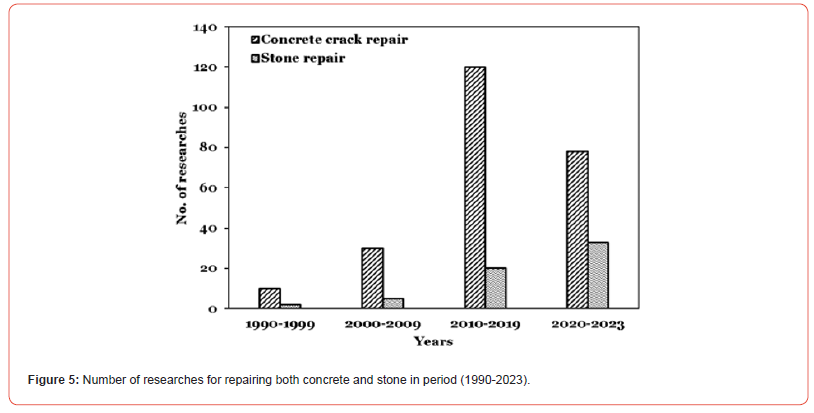
Types of bacteria used in construction materials
In construction, there are various types of bacteria used. The use of bacteria in the construction field has a number of potential benefits, including increasing the durability and strength of concrete, the ability to heal micro-cracks, and reducing the impact of the environment on the concrete. Thus, the most common use in the construction field is shown in Table 2, Figure 6.
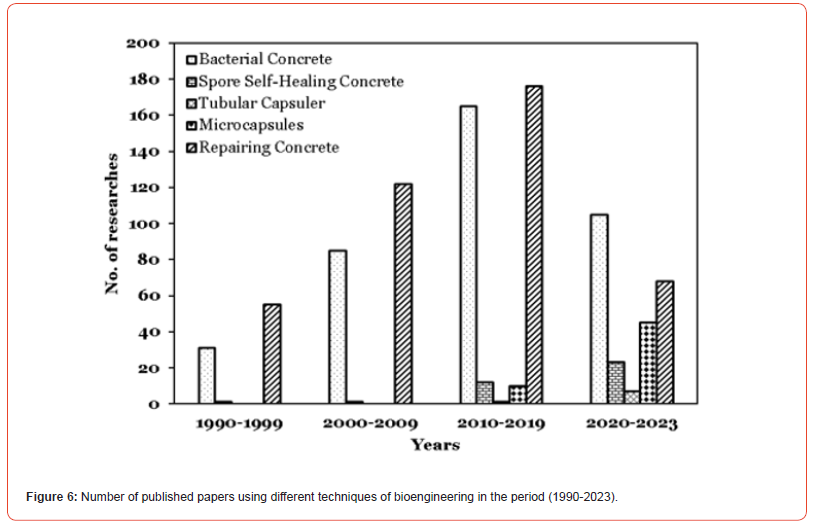
Table 2: Different bacteria used in different building materials in the literature.

Summary of advantages and disadvantages of used bacteria in concrete
The utilization of bacteria in concrete presents both advantageous and disadvantageous aspects. On the positive side, bacteria offer a promising solution for the remediation of external cracks when introduced alongside nutrients and sand into these cracks. This process triggers the formation of calcite, resulting in increased strength and stiffness of the concrete. Furthermore, these bacteria can play a dual role in construction by aiding in the development of biologically derived binders and surface treatments for stones. Whether employed for external self-healing or integrated into bio-concrete, the application of bacteria is associated with improvements in compressive strength and enhanced durability. Additionally, bacterial intervention reduces permeability, thereby mitigating the potential for corrosion in reinforced concrete structures. Importantly, the precipitation material generated through bacterial action seamlessly integrates with the original concrete composition.
However, there are notable downsides to consider. The initial cost of bacterial concrete is considerably higher compared to traditional concrete, although this initial investment is offset by subsequent reductions in maintenance expenses. Notably, different bacterial strains necessitate distinct nutrient compositions and specific atmospheric conditions for optimal performance. Furthermore, safeguarding bacteria from the detrimental effects of high pH in concrete requires additional measures. A lack of standardized mix design for bacterial concrete poses a challenge, as there is currently no established code governing these formulations. Finally, it’s important to acknowledge that incorporating bacteriafilled capsules into the concrete mixture might lead to a reduction in compressive strength due to the increased volume of capsules within the material.
In this review chapter, our findings underscore the most promising domain in the realm of self-healing concrete, as indicated in Figure 7. Notably, the figure reveals that the area with the most potential for fruitful research lies within autogenous healing, while conversely, autonomic healing appears to be the least explored aspect in this field.

In Figure 8, the number of publications including minerals and bacteria is presented. It is obvious from the figure that the research field related to minerals is in high demand compared to the field concentrated on bacteria. This is primarily attributed to the inclusion of mineral-based approaches, which are observed to provide more predictable and reliable results in terms of crack healing, as opposed to the bacteria-centered research field.
Tests of self-healing capabilities
Over the past decade, there has been a notable increase in efforts to innervate concrete’s resistance to environmental deterioration through the application of self-healing techniques. However, a major challenge remains in the field of materials classification, mainly due to the lack of standardized criteria for evaluating self-healing test results. This prevailing lack of universally accepted assessment standards has become a major obstacle in this area. Therefore, the researchers [72] have prioritized the establishment of a universally applicable standard procedure for the comprehensive evaluation of self-healing capabilities
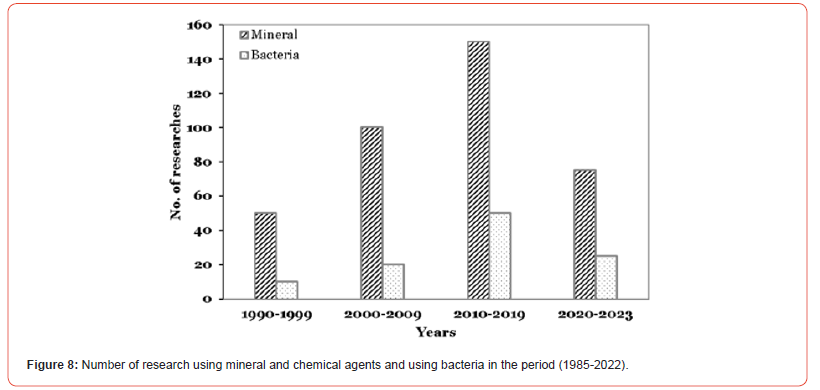
In practice, a set of techniques and tests are implemented to evaluate healing capacity and performance. Among them, visualization tests, especially those using scanning methods, are very popular. When it comes to evaluating the self-healing effectiveness of cracks, permeability tests are popular. Furthermore, the 3-point bending test, shown in Figure 10, is a widely recognized and used method to evaluate the recovery of mechanical properties of self-healing materials.
Summary and Discussion
The objective of this review is to furnish an encompassing perspective on various methodologies that enable the quantitative assessment of distinct self-healing strategies. These strategies encompass intrinsic healing with crack control width, bacterial encapsulation and crack repair, chemical encapsulation, chemical encapsulation in glass tubing, and mineral admixture.
Chemical encapsulation
A diverse range of chemical agents, such as epoxy [24], Na2SIO3 [30], and retarder agents [73], as well as various shell materials like gelatin [74], wax [73], ceramics [29], and glass [19] have been employed in the microencapsulation technique to facilitate chemical self-healing in concrete Figure 9.
The advantages associated with chemical encapsulation within microcapsules for enhancing concrete self-healing are remarkable.
Firstly, it offers the potential for extended service life, which is provisional upon the concentration of the healing agent contained within these capsules. Additionally, this approach enables the simultaneous healing of multiple defects, thereby expediting repair processes. The uniform dispersion of these capsules throughout the concrete matrix ensures comprehensive healing potential. Moreover, the encapsulation method allows for the preservation of healing agents, enabling their deployment for future use. Furthermore, when the healing process is initiated, it leads to the restoration of mechanical strength, contributing to the overall structural integrity of the concrete.
Nonetheless, certain limitations associated with the chemical encapsulation technique warrant consideration. A significant concern apportions to the uncertainty surrounding the strength of the bond between the microcapsules and the surrounding concrete matrix. The reliability of this approach is obstructed by the limited availability of comprehensive data, making precise assessments challenging. Importantly, an increased use of capsules within the concrete mixture can potentially lead to a reduction in the stiffness of the cross-sectional area. Furthermore, the response of this method to varying climatic conditions remains inadequately studied, with a lack of comprehensive insights into its performance in different environmental settings. Additionally, it is essential to note that prior tests have predominantly focused on single-loading cycles, without exploring the behavior of repeated healing cycles.
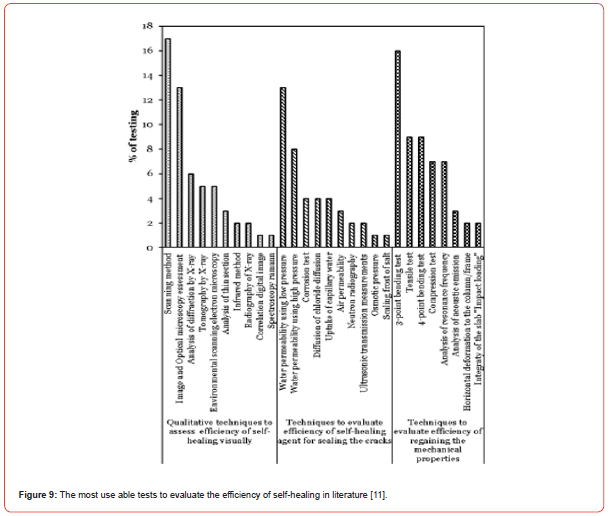
Mineral Admixtures for Concrete Self-Healing
Mineral admixtures have emerged as a valuable tool for promoting self-healing in concrete cracks by facilitating the deposition of crystals within these fissures. Kashi [75] employed expansive agents like (C4A3S, CaSO4 and CaO), while other researchers [76-79] opted to replace a portion of cement with materials such as fly ash or blast furnace slag. They observed effective healing for cracks up to 0.22mm in width. Furthermore, Ahn and Kishi [80,81] demonstrated that by substituting 10% of the cement with a combination of chemical agents, geo-materials, and expansive agents, significant progress can be made in terms of crack healing.
Mineral admixtures hold promise as a means of enhancing concrete self-healing, offering several advantages while also presenting notable challenges. On the advantageous side, mineral admixtures have demonstrated their efficiency in promoting crack closure and effective healing. Their compatibility with the underlying cement matrix ensures seamless integration, contributing to improved structural integrity. Moreover, the durability of the healing effect is closely tied to the reactivity of additives and anhydrate materials, a factor that is carefully considered. The even distribution of mineral admixtures throughout the concrete mixture further enhances their healing potential, and their applicability in underground structures highlights their versatility.
However, the utilization of mineral admixtures comes with its set of challenges. Managing potential expansion to prevent undesirable consequences demands meticulous attention. Additionally, ensuring the attainment of the desired level of healing remains uncertain. The scarcity of comprehensive data limits their efficacy as a guide for precise assessment. Furthermore, the impact of diverse climatic conditions on their performance remains an unexplored aspect, necessitating further research to gain a comprehensive understanding of their behavior. In light of these considerations, the utilization of mineral admixtures for concrete self-healing warrants careful exploration, taking into account both their advantages and disadvantages.
Chemical in glass/fiber vascular tubing
The glass vascular tubing system consists of a network of hollow tubes connecting both internal and external cracks within a concrete structure. There are two primary types of vascular tubing systems: the single-channel vascular tubing, as studied by Joseph et al.. [82,83] and the multi-channel tubing system, whose efficiency has been explored by Mihashi et al. [84] and Dry and Mcmillan [85]. These systems operate in two distinct modes: the active mode involves the healing of cracks through the embedded tubes within the concrete, while the passive mode relies on the discharge of selfhealing agents from outside the structure container through the glass tubes. The outcomes of these studies indicate that the active mode contributes to enhanced crack tightness, whereas the passive mode improves flexural toughness.
The ability to tailor the release of healing agents to specific requirements enhances adaptability, catering to diverse scenarios. Moreover, the effectiveness of fibers in responding to multifaceted damages ensures a resilient structural response and contributes to overall robustness. The longevity of these systems varies based on the chosen healing agent, offering sustained benefits over time. However, it is important to acknowledge that while notable strength and tightness gains are achieved, full self-healing efficiency may not always be realized. The system also demonstrates compatibility with a range of healing agents, adding versatility to its application. Furthermore, the immune nature of these systems to external environmental influences ensures a consistent and reliable healing mechanism.
Nonetheless, the utilization of glass fiber vascular tubing systems presents specific challenges. Challenges arise during the orientation and casting of glass fibers, demanding careful handling. An increase in the number of tubes leads to reduced structural cross-section efficacy and affects overall mechanical properties. The scarcity of comprehensive data from previous studies poses a hindrance to a comprehensive assessment of their effectiveness. Moreover, the brittleness of glass tubes limits their reusability for healed cracks, potentially affecting their long-term applicability. Additionally, the introduction of glass tubes into the system may influence the cement matrix, necessitating careful consideration. In conclusion, the incorporation of glass/fiber vascular tubing systems for concrete self-healing represents a balance between advantageous attributes and potential limitations, necessitating prudent evaluation of their application.
Different applications of Bacteria in concrete
Numerous researchers have ventured into the realm of selfhealing concrete, focusing on the application of bacterial spores as a promising avenue. Pioneering work by Jonkers et al.. [86] provided a thorough examination of advancements in self-healing concrete, shedding light on the potential utility of bacterial spores as an effective agent for autonomous repair. A more in-depth exploration of the bacterial spores approach was conducted by Wintor and Jonkers [87], where they identified crucial challenges that must be addressed to facilitate the practical implementation of this innovative method.
In a parallel effort, Wang et al.. [71] conducted a rigorous investigation into the efficacy of various bacterial spore strains for self-healing concrete. Their research highlighted Bacillus subtilis spores as the most promising option for achieving optimal results. Furthermore, in 2019, Chen et al.. [88] meticulously examined the incorporation of bacterial spores immobilized within ceramsite for self-healing concrete. This novel approach demonstrated a remarkable ability to remediate cracks measuring up to 0.46 mm in width, marking significant progress in the field. Offering a contemporary perspective, the comprehensive review by Kumar and Gupta in 2022 [89] encapsulated recent advancements in selfhealing concrete. Their assessment firmly positioned the use of bacterial spores as one of the most promising pathways forward, emphasizing its substantial potential to revolutionize the field.
Intrinsic (autogenous and autogenomic) healing
The phenomenon of intrinsic crack healing within the concrete matrix has garnered significant attention in the literature [13-15]. This particular phenomenon can be categorized into two distinct types: autogenous and autogenomic healing, as elucidated in section 2. Remarkably, this phenomenon is capable of healing cracks of considerable dimensions, up to 300 micrometers [22], owing to the enduring mechanisms of ongoing pozzolanic reactions and carbonation in cementitious materials. Importantly, intrinsic crack healing continues to occur as long as the pozzolanic material and environmental conditions remain conducive.
Intrinsic crack healing offers several notable advantages. Firstly, it demonstrates environmental compatibility, aligning with sustainable practices. Furthermore, it boasts an extended operational lifespan and proves economically viable due to its costeffectiveness. The even distribution of healing agents throughout the structural matrix enhances its effectiveness. Following healing, the treated material exhibits improvements in both crack tightness and mechanical strength. Moreover, the capacity of the healing material to augment its strength even after exposure to multiple loading cycles and diverse environmental conditions underscores its resilience.
However, this approach is not without its inherent limitations. Its effectiveness is primarily confined to addressing smaller crack widths, limiting its applicability in contexts involving larger fissures. Additionally, its performance is susceptible to environments rich in alkaline and chloride components, posing challenges to consistent performance. The absence of comprehensive and sufficient empirical data further hinders a thorough assessment of its potential and limitations.
Conclusion
In this comprehensive review, we have examined five distinct self-healing approaches: bacterial concrete, mineral admixture, chemical encapsulation, a chemical in-glass tubing encapsulation, and intrinsic healing with limitations on crack width. Our investigation reveals that each approach exhibits a certain degree of effectiveness, yet it remains challenging to definitively determine the superiority of one over the others. Notably, autogenous healing, while confined to smaller crack healing and characterized by relatively lower reliability, has historically received substantial research attention, although it represents only a facet of the broader self-healing landscape. The critical assessment of these self-healing strategies, as elucidated in this chapter, underscores their interdisciplinary nature, encompassing microbiology, chemistry, civil engineering, and materials science. A promising avenue for future research involves the integration of these diverse approaches to formulate novel self-healing methodologies. However, the tangible benefits of these self-healing techniques, such as cost reduction and enhanced structural longevity, can only be fully realized through practical implementation on actual construction sites.
Achieving these desired outcomes necessitates the development of concrete mix designs tailored to the principles of each approach, alongside the establishment of a standardized testing protocol for evaluating healed materials and the formulation of international benchmarks. Furthermore, it is imperative to conduct comprehensive research focusing on the mechanical properties, stress responses, and long-term durability of the healed sections. In conclusion, the progression of this field demands a concerted commitment to rigorous research and interdisciplinary collaboration, steering the evolution of self-healing methodologies toward pragmatic and enduring solutions that advance the realm of structural engineering.
Acknowledgement
None.
Conflict of Interest
No Conflict of interest.
References
- Reinhardt HW, Jooss M (2003) Permeability and self-healing of cracked concrete as a function of temperature and crack width. Cement and Concrete Research 33(7): 981-985.
- Sukhotskaya SS, Mazhorova VP, Terekhin YN (2004) Effect of autogenous healing of concrete subjected to periodic freeze-thaw cycles. Magazine of Concrete Research 56(10): 633-640.
- Edvardsen C (1999) Water permeability and autogenous healing of cracks in concrete. ACI Materials Journal 96(4): 448-454.
- Chen X, Yuan J, Alazhari M (2019) Effect of Microbiological Growth Components for Bacteria-Based Self-Healing on the Properties of Cement Mortar. Materials 12(8): 1334.
- Reinhardt HW, Jonkers H, Van Tittelboom K, Snoeck D, De Belie N, et al. (2013) Recovery against environmental action. In: Self-Healing Phenomena in Cement-Based Materials. Springer, Dordrecht: 65-117.
- Hannant DJ, Keer JG (1983) Autogenous healing of thin cement-based sheets. Cement and Concrete Research 13(3): 357-365.
- Powers TC (1956) Autogenous healing of cement paste. ACI Journal Proceedings 52(6): 591-608.
- Igarashi S, Kunieda M, Nishiwaki T (2009) Technical Committee on Autogenous Healing in Cementitious Materials. Committee Report: JCI-TC075B: 91-102.
- RILEM (2013) Self-Healing Phenomena in Cement-Based Materials - State-of-the-Art Report of RILEM Technical Committee 221-SHC. Springer.
- Van Tittelboom K, De Belie N (2013) Self-healing in cementitious materials-A review. Materials 6(6): 2182-217.
- Mohamed S, Alazhari (2014) Development of self-healing concrete by using different types of bacteria. [PhD thesis]. UK: Bath; University of Bath.
- Zwaag van der S (2007) Self-Healing Materials - An Alternative Approach to 20 Centuries of Materials Science. Netherlands: Springer, pp. 391.
- Neville A (2002) Autogenous healing: a concrete miracle? Concrete International Institute 24(11).
- Ramm W, Biscoping M (1998) Autogenous healing and reinforcement corrosion of water-penetrated separation cracks in reinforced concrete. Nuclear Engineering and Design 179(2): 191-200.
- Yang Y, Lepech MD, Yang EH, Li VC (2009) Autogenous healing of engineered cementitious composites under wet–dry cycles. Cement and Concrete Research39(5):382-390.
- Wang S, Urban MW (2020) Self-healing polymers. National Review Materials 5(8): 562–583.
- Cappellesso V, Silva DMG, Arndt J, Petry N, Masuero AB, et al. (2019) Self-Healing Phenomenon Evaluation in Cementitious Matrix with Different Water/Cement Ratios and Crack Opening Age. In: International Conference on Self-Healing Concrete in Civil Engineering Applications (ICSHCCEA).
- Hearn N (1998) Self-sealing, autogenous healing and continued hydration: What is the difference? Materials and Structures 31(8): 563-567.
- Thao TDP, Johnson TJS, Tong QS, Dai PS (2009) Implementation of self-healing in concrete - Proof of concept. IES Journal Part A: Civil and Structural Engineering 2(2): 116-125.
- Lark RJ, Al-Tabbaa A, Paine K (2013) Biomimetic mulite-scale damage immunity for construction materials: M4L Project overview. In: Proceedings of the 4th International Conference on Self-Healing Materials, Ghent, Belgium. pp. 2-5.
- Edvardsen C (1999) Water permeability and autogenous healing of cracks in concrete. ACI Mater Journal 96(4): 448-454.
- Clear CA (1985) The effects of autogenous healing upon the leakage of water through cracks in concrete. Tech. Rep. 559, Cement and Concrete Association.
- Boh B, Šumiga B (2008) Microencapsulation technology and its applications in building construction materials. RMZ–Materials and Geo environment Journal 55(3): 329-344.
- White SR, Sottos NR, Geubelle PH, Moore JS, Kessler MR, et al. (2001) Autonomic healing of polymer composites. Nature Journal 409(6822): 794-797.
- Jonkers HM, Thijssen A, Muyzer G, Copuroglu O, Schlangen E (2010) Application of bacteria as self-healing agent for the development of sustainable concrete. Ecological Engineering Journal 36(2): 230-235.
- Wang J, Van Tittelboom K, De Belie N, Verstraete W (2012) Use of silica gel or polyurethane immobilized bacteria for self-healing concrete. Construction and Building Materials 26(1): 532-540.
- Nishiwaki T, Mihashi H, Okuhara Y (2010) Fundamental study on self-repairing concrete using a selective heating device. In: Proceedings of the 5th International Conference on Concrete under Severe Conditions: Environment and Loading, CRC Press/Balkema, pp. 919-926.
- Alazhari M, Sharma T, Heath A, Cooper R, Paine K (2018) Application of expanded perlite encapsulated bacteria and growth media for self-healing concrete. Construction and Building Materials 160: 610-619.
- Van Tittelboom K, De Belie N, Van Loo D, Jacobs P (2011) Self-healing efficiency of cementitious materials containing tubular capsules filled with healing agent. Cement and Concrete Composites Journal 33(4): 497-505.
- Pelletier MM, Brown R, Shukla A, Bose A (2011) Self-healing concrete with a microencapsulated healing agent. Journal of Materials in Civil Engineering 23(11): 1267-1276.
- Huang Y, Wang X, Sheng M, Qin D, Ren J, et al., (2021) Dynamic behavior of microcapsule-based self-healing concrete subjected to impact loading. Construction and Building Materials 288: 122783.
- Du W, Yu J, Gu Y, Li Y, Han X, et al., (2019) Preparation and application of microcapsules containing toluene-di-isocyanate for self-healing of concrete. Construction and Building Materials 202:762-769.
- Cui JH, Goh JS, Park SY, Kim PH, Lee BJ (2017) Preparation and physical characterization of alginate microparticles using the air atomization method. Carbohydrate Polymers 175: 1034-1041.
- Bajpai SK, Tankhiwale R (2008) Preparation, characterization, and preliminary calcium release study of floating sodium alginate/dextran-based hydrogel beads: part I. Journal of Biomedical Materials Research Part B: Applied Biomaterials 85(2): 373-80.
- Bakar SAA, Khan MA, Ilyas MR (2020) Self-healing performance of microcapsule-based cementitious composites under different environmental conditions. Construction and Building Materials 265: 120829.
- Granger S, Loukili A, Pijaudier-Cabot G, Chanvillard G (2007) Mechanical characterization of the self-healing effect of cracks in Ultra High-Performance Concrete. Cement and Concrete Research Journal 37(4): 519-527.
- Hilloulin B, Van Tittelboom K, Gruyaert E, De Belie N, Loukili A (2015) Design of polymeric capsules for self-healing concrete. Cement and Concrete Composite Journal 55: 298-307.
- Wang JY, Soens H, Verstraete W (2011) Self-healing concrete by use of microencapsulated bacterial spores. Journal of Materials in Civil Engineering 23(11):1267-1276.
- Re Ren J, Wang X, Li D, Han N, Dong B, et al. (2021) Temperature adaptive microcapsules for self-healing cementitious materials. Construction and Building Materials 288: 122783.
- Jiang S, Lin Z, Tang C, Hao W (2021) Preparation and Mechanical Properties of Microcapsule-Based Self-Healing Cementitious Composites. Materials 14(17): 4866.
- Maslehuddin MA, Khan MA, Ilyas MR (2022) Development of a self-healing concrete containing microcapsules with a high content of healing agent. Construction and Building Materials 297: 123662.
- Wang JY, Soens H, Verstraete W, De Belie N (2014) Self-healing concrete by use of microencapsulated bacterial spores. Cement and Concrete Research Journal 56: 139-152.
- Bakar SAA, Khan MA, Ilyas MR (2022) Self-healing behavior of cementitious composites with microcapsules containing different types of healing agents. Construction and Building Materials 295: 123554.
- Reda MA, Chidiac SE (2022) Performance of capsules in self-healing cementitious material. Construction and Building Materials 298: 123853.
- Dry C, Corsaw M, Bayer E (2003) A comparison of internal self-repair with resin injection in the repair of concrete. Journal of Adhesion Science Technology 17(1) :79-89.
- Dry CM, Sottos NR (1993) Passive smart self-repair in polymer matrix composite materials. Journal of Materials Science 28(16): 4333-4338.
- Dry C (1993) Passive Smart Materials for Sensing and Actuation. Journal Intelligent Materail Systems and Structurers 4(3): 420-425.
- Dry CM (1997) Release of smart chemicals for the in-service repair of bridges and roadways. Transportation Research Record: Journal of the Transportation Research Board 1584: 128-135.
- Dry CM, Corsaw MJT (1998) A time-release technique for corrosion prevention. Cem Concr Res 28(8): 1133-1140.
- Sangadji S, Schlangen E (2012) Self-Healing of Concrete Structures - Novel Approach Using Porous Network Concrete. Journal of Advanced Concrete Technology 10(5): 185-194.
- Nishiwaki T, Mihashi H, Jang BK, Miura K (2006) Development of Self-Healing System for Concrete with Selective Heating around Crack. Journal of Advanced Concrete Technology 4(2): 267-275.
- De Muynck W, De Belie N, Verstraete W (2010) Microbial carbonate precipitation in construction materials: A review. Ecological Engineering Journal 36(2): 118-136.
- Alazhari M, Chen X, Sharma T, Cooper R, Heath A, et al., (2019) Effects of bacterial self-healing agents on properties of cement mortar. Construction and Building Materials 226: 486-495.
- Jonkers HM, Schlangen E (2009) Towards a sustainable bacterially mediated self-healing concrete. In: Proceedings of 2nd International Conference on Self-Healing Materials, Chicago.
- Ferris FG, Stehmeier LG (1992) Bacteriogenic mineral plugging. US Patent 5,143,155 A.
- Rivadeneyra MA, Delgado G, Ramos-Cormenzana A, Delgado R (1998) Biomineralization of carbonates by Halomonas eurihalina in solid and liquid media with different salinities: crystal formation sequence. Research in Microbiology Journal 149(4): 277–287.
- Hammes F (2003) Ureolytic microbial calcium carbonate precipitation. PhD thesis, Ghent University, Ghent.
- Pierre AJ, Loubiere JF, Parada J, Soleilhavoup F (1990) Process for the biological treatment of an artificial surface. European Patent 0,388,304 A1.
- Rodriguez-Navarro C, Rodriguez-Gallego M, Chekroun KB, Gonzalez-Muñoz MT (1990) Conservation of ornamental stone by Myxococcus xanthus-induced carbonate biomineralization. Applied and Environmental Microbiology ASM. X 69(4): 2182-2189.
- Hammes F, Seka A, de Knijf S, Verstraete W (2003) A novel approach to calcium removal from calcium-rich industrial wastewater. Water Researcj Journal 37(3): 699-704.
- De Muynck W, Cox K, Belie ND, Verstraete W (2008) Bacterial carbonate precipitation as an alternative surface treatment for concrete. Construction and Building Materials 22(5): 875-885.
- De Muynck W, Debrouwer D, De Belie N, Verstraete W (2008) Bacterial carbonate precipitation improves the durability of cementitious materials. Cement and Concrete Research 38(7): 1005-1014.
- Jimenez-Lopez C, Jroundi F, Pascolini C, Rodriguez-Navarro C, Piñar-Larrubia G, et al., (2008) Consolidation of quarry calcarenite by calcium carbonate precipitation induced by bacteria activated among the microbiota inhabiting the stone. Intnational Biodeterioration & Biodegradation Journal 62(4): 352-363.
- Le Métayer-Levrel G, Castanier S, Orial G, Loubière JF, Perthuisot JP (1999) Applications of bacterial carbonatogenesis to the protection and regeneration of limestones in buildings and historic patrimony. Sediment Geol 126(1-4): 25-34.
- Ramachandran SK, Ramakrishnan V, Bang SS (2001) Remediation of concrete using microorganisms. ACI Mater Journal 98(1): 3-9.
- Yuan J, Chen X, Alazhari M, Yang B, Zhang G (2019) Characterisation of bacteria-based concrete crack rejuvenation by externally applied repair. Construction and Building Materials 226: 486-95.
- Achal V, Mukherjee A, Basu PC, Reddy MS (2009) Lactose mother liquor as an alternative nutrient source for microbial concrete production by Sporosarcina pasteurii. J Ind Microbiol Biotechnol 36(3): 433-438.
- Ghosh P, Mandal S, Chattopadhyay BD, Pal S (2005) Use of microorganisms to improve the strength of cement mortar. Cement and Concrete Research 35(10): 1980-1993.
- Ramakrishnan V, Panchalan RK, Bang SS (2005) Improvement of Concrete Durability by Bacteria Mineral Percipitation. ICF11, pp. 1-7.
- Jonkers HM, Schlangen E (2007) Crack repair by concrete-immobilized bacteria. In: Proceedings of the first international conference on self-healing materials Noordwijk, The Netherlands, pp. 1-7.
- Wang JY (2010) self-healing concrete using microorganisms. 2nd CSC PhD Stud Workshop Gent, pp. 11-22.
- De Belie N, Van der Zwaag S, Gruyaert E, Van Tittelboom K, Debbaut B (2013) ICSHM 2013: Proceedings of the 4th International Conference on Self-Healing Materials, Ghent, Belgium, 16-20 June 2013. ICSHM 2013, pp. 118-122
- Mihashi H, Nishiwaki T, Kaneko Y, Nishiyama N (2002) Development of smart concretes. Proc 1st Fib Congress Osaka Japan 141-154
- Cailleux E, Pollet V (2009) Investigations on the development of self-healing properties in protective coatings for concrete and repair mortars. In: Proceedings of the 2nd International Conference on Self-Healing Materials. Chicago, IL 1-7.
- Kishi T, Ahn TH, Hosoda A, Suzuki S, Takaoka H (2007) Self-Healing Behaviour by Cementitious Recrystallization of Cracked Concrete Incorporating Expansive Agent. In: Proceedings of the First International Conference on Self-Healing Materials. Noordwijk, The Netherlands 10-17.
- Şahmaran M, Keskin SB, Ozerkan G, Yaman IO (2019) Self-healing of mechanically loaded self-consolidating concretes with high volumes of fly ash. Construction and Building Materials 225: 753-762.
- Ter Heide N (2005) Crack Healing in Hydrating Concrete. Master's thesis. Delft, The Netherlands: Delft University of Technology.
- Li VC, Wu C, Wang S, Ogawa A, Saito T (2002) Interface Tailoring for Strain-Hardening Polyvinyl Alcohol-Engineered Cementitious Composite (PVA-ECC). ACI Materials Journal 99(5): 463-472.
- Termkhajornkit P, Nawa T, Yamashiro Y, Saito T (2009) Self-healing ability of fly ash-cement systems. Cement and Concrete Composites 31(3): 195-203.
- Kishi T, Ahn TH (2008) The effect of geo-materials on the autogenous healing behavior of cracked concrete. In: Alexander M, Beushausen HD, Dehn F, Moyo P, editors. Concrete Repair, Rehabilitation and Retrofitting II. CRC Press 125-126.
- Ahn TH, Kishi T (2010) Crack Self-healing Behavior of Cementitious Composites Incorporating Various Mineral Admixtures. Journal of Advanced Concrete Technology 8(2): 171-86.
- Thao TDP, Johnson TJS, Tong QS, Dai PS (2009) Implementation of self-healing in concrete - Proof of concept. IES Journal Part A: Civil and Structural Engineering 2(2): 116-25.
- Lark B, Gardner D, Jefferson T, Joseph C, Isaacs B (2011) Self-healing cementitious materials: a review of recent work. Proc ICE - Construction Materials 164(1): 29-41.
- Mihashi H, Kaneko Y, Nishiwaki T, Otsuka K (2000) Fundamental study on development of intelligent concrete characterized by self-healing capability for strength. Transactions of the Japan Concrete Institute 22: 441-450.
- Dry C, McMillan W (1996) Three-part methylmethacrylate adhesive system as an internal delivery system for smart responsive concrete. Smart Materials and Structures 5(3): 297.
- Jonkers HM (2007) Self-Healing Concrete: A Biological Approach. In: Zwaag PS van der, editor. Self-Healing Materials. Dordrecht: Springer, 195-204.
- Wiktor V, Jonkers HM (2011) Assessment of the crack healing capacity in bacteria-based self-healing concrete. Construction and Building Materials 25(1): 305-11.
- Chen J, Liu P, Zhang Y, Zhang L (2020) Self-healing of concrete using bacterial spores immobilized in ceramsite: A review. Construction and Building Materials 256:119736.
- Kumar R, Gupta A (2022) Self-healing concrete: A review of recent developments and challenges. Journal of Materials Science 57(2): 1153-72.
-
Mohamed Alazhari*. A Comprehensive Evaluation of Sustainable Self-Healing Cementitious Materials-Review. On Journ of Robotics & Autom. 2(3): 2023. OJRAT.MS.ID.000537.
Mathematics & Statistics, Modern Warfare, Autonomous Weapons, Robotics, Unmanned vehicles, Drones, Ethics.
-

This work is licensed under a Creative Commons Attribution-NonCommercial 4.0 International License.






